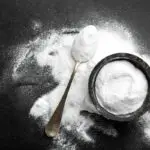When you’re baking homemade bread or homemade pizza, a baking stone is an invaluable tool. When you bake on a stone surface it creates high heat that spreads evenly to give you a perfect bake. Baking on a stone surface also means you don’t have to move the bread around as much.
If you don’t have a baking stone at home – whether because of budget limitations, or because you’re new to baking – don’t worry! There are many alternatives to baking stones that will still get you amazing baking results every time.
Baking Pan Or Bread Molds
Freshly baked bread is perfect for making sandwiches, as their square shape makes slices naturally even. Meanwhile, round loaves are better for meals where bread is served as a side dish. What sets a bread mold apart from a cake mold is its shapes and the angles of the sides.
When baking bread in a baking pan or bread mold, the walls are at a right angle to the base. Meanwhile for cakes, the sides are often at a slight outward angle. There are a few kinds of bread baking molds out there, and you find them made of aluminum, cast iron, or ceramic.
We personally recommend a cast iron pan or a ceramic pan as they keep the bread nice and hot. Plus, iron has an appealing, rustic look! The main difference between these materials is heat distribution (how well the heat spreads over a baking surface), and heat retention (how long the material holds the heat).
Bread Cloche
There are a few kinds of bread cloches available, but we personally love clay bread cloches! A bread cloche has two parts. These are the dome and the base. Baking bread in a vessel that has a lid makes capturing the steam inside easier, a lot like Pyrex and a Dutch Oven, and will give you a bread with a crisp crust, while leaving the inside deliciously chewy and soft.
The biggest benefit to using a bread cloche is the baking surface itself. A bread cloche has a deep lid and a thin base, while a Dutch Oven has a deep pot and a thin lid. A thinner base makes loading the bread and scoring it safer, while scoring bread in a Dutch oven might be difficult, as it can be a challenge to get the right angle when scoring your bread.
Loading bread into a Dutch Oven can also be challenging when the iron pot is piping hot. A lot of home bakers – especially those new to baking – may panic and drop their bread, which can deflate the bread. But the thin surface of a cloche solves this problem.
Much like the Dutch Oven, you must preheat the dome and surface of the cloche. Once it’s reached the required temperature, you can load and score the bread before placing it in the oven. When you’re halfway or two-thirds of the way through baking, take off the lid and continue baking until you get the color you desire.
Baking Sheets
Baking bread on a baking sheet is great for Challah bread, dinner rolls, or any type of bread with a soft crust. It is suitable for all types of bread actually, but a cast iron skillet is better for bread that requires high temperatures.
There are many baking sheets you can bake bread on, but we recommend a commercial, heavy aluminum baking sheet. The biggest benefit of a baking sheet is how evenly and quickly they heat up. They make an amazing alternative to a baking stone!
Dutch Oven

If you’ve ever baked bread in a Dutch oven, you know how easy it is to bake bread using one! It is probably the best way to achieve a professional level bake. Your loaves are likely to be evenly baked and have a thick, crisp crust. After all, don’t we all want that for the bread we bake?
In a lot of ways, baking bread in a Dutch oven is better than baking it on a baking stone because of the heat distribution given to the bread, and how much steam is generated. The Dutch oven’s pot works like an incubator for the bread.
The iron construction of the Dutch oven gets heated and then heats all sides of the bread evenly. This is in contrast to a baking stone that only radiates heat from the bottom. You must be careful using a Dutch oven however, because it can make the crust of the bread thinner, or even burn a little on the bottom.
However, this all depends on what heating elements your oven has. It is incredibly important to preheat your Dutch oven for around 45 minutes before you put the bread in. The ideal temperature would be 210 °C , and for sourdough bread it would be 410 °F.
Alternatives To Pizza Stones
Much like baking bread, you don’t need a pizza stone for baking pizza at home. A pizza stone helps keep your oven hot and gives you the crispiest pizza crust possible, but there are many alternatives that help you achieve similar results when baking pizza. The below alternatives have their own individual benefits and some you may already have in your kitchen. Make use of these tools for easily baking pizza!
Baking Steel
While baking steel isn’t a popular kitchen tool, it’s one of the best alternatives to a pizza stone. Baking steels are strong, durable pieces of steel that are made to withstand high temperatures. Some people prefer baking steel to pizza stones because of their large surface area that lets you bake two pizzas at once! They’re also super easy to store as well as being practically indestructible.
Inverted Baking Sheets
Another amazing pizza stone alternative is an inverted baking sheet. Just grab a rimmed baking sheet and before preheating your oven, invert it on the bottom shelf of your oven. You will then be able to effortlessly slide the pizza dough onto the baking sheet when it’s ready to bake.
The inverted baking sheet surface will be warm enough to crisp the pizza up, and simplifies taking your pizza in and out of the oven than it would be if the baking sheet was facing the right way. Another DIY pizza stone alternative is grilling your pizza. Who doesn’t love a grilled pizza, after all?
Pizza Pan
Pizza pans are pretty budget friendly and are also simple to store. We recommend looking for a pizza pan made of heavy aluminum that has either a ridged design that gives the pizza crust access to air flow, or a pizza steel pan that has air vents. We also recommend avoiding nonstick pans, it will be a little rougher cleaning the pan but trust us, it’s worth it!
Final Thoughts
We hope our article has shown you there are many great alternatives out there for baking stones! Some are traditional, tried-and-true alternatives, while others are a little more out-there. While all these alternatives will get the job done, you just need to decide which one is the best for you. What is your favorite stone alternative?










